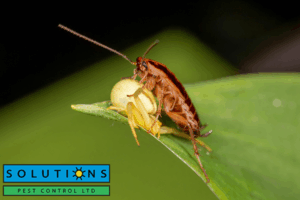Spotting a dark, fast-moving insect in your home is never a pleasant surprise. Most people immediately assume they’ve encountered a cockroach and understandably so. Cockroaches are notorious for their resilience, rapid reproduction, and unsanitary habits. But not every creepy crawler is actually a roach. In fact, several other insects can look strikingly similar, leading to confusion, unnecessary panic, or even incorrect pest control measures.
In this article, we’ll break down some of the most common bugs that look like cockroaches, how to tell them apart, and what steps you should take if you suspect a pest infestation in your home.
Why Does It Matters: Roach or Not?
Identifying the pest correctly is crucial for effective treatment. Different insects require different strategies for control, and mistaking one for another can result in wasted time and ineffective solutions. While cockroaches are harmful and difficult to eliminate once they’ve established themselves, not all roach-like insects pose the same risks. Knowing what you’re dealing with helps you take the right action quickly and confidently.
Common Types of Bugs That Look Like Cockroaches
Let’s explore several types of bugs that look like cockroaches and how you can differentiate them.
1. Crickets
Crickets are often mistaken for cockroaches because of their similar size and color. However, crickets have long legs designed for jumping and are usually more active at night. They also produce a recognizable chirping sound, something cockroaches do not do. Unlike roaches, crickets are less of a health threat but can still cause damage by chewing on fabrics and paper products.
How to tell the difference:
Look for long hind legs and antennae. Crickets also tend to have a rounded body shape compared to the flatter profile of cockroaches.
2. Beetles
Certain types of beetles, like ground beetles or wood-boring beetles, can resemble small cockroaches. However, beetles typically have hardened wing covers and a more uniform, shiny appearance. They move more slowly and tend not to scatter when exposed to light, unlike cockroaches.
How to tell the difference:
Check for a shiny, shell-like covering and note the insect’s movement. If it crawls slowly and doesn’t hide from light, it’s probably a beetle.
3. Bed Bugs
Though smaller and rounder than cockroaches, bed bugs can be mistaken for baby roaches. Bed bugs are reddish-brown and flat, particularly after feeding. They’re usually found in or near beds, upholstered furniture, or electrical outlets.
How to tell the difference:
Bed bugs are much smaller and found in very specific places, mainly bedrooms. If you’re seeing bugs around your bed or noticing small blood spots on sheets, you might be dealing with bed bugs, not roaches.
4. Water Bugs
This is one of the most common cases of mistaken identity. “Water bug” is often used interchangeably with cockroaches, but they are not the same. True water bugs are aquatic insects and are much larger than cockroaches. They’re not commonly found inside homes and usually live near ponds or streams.
How to tell the difference:
If it’s much larger and found near water sources outside the home, it’s probably a water bug.
5. Earwigs
Earwigs are brown insects with a similar body shape to roaches but are easily identified by their distinctive pincers at the end of their abdomen. While they might look scary, earwigs are not harmful to humans and usually don’t infest homes in large numbers.
How to tell the difference:
Check for pincers and a more segmented body. Earwigs also don’t scatter in the same frantic manner as cockroaches.
Where You Might Spot These Lookalikes
Insects that resemble cockroaches are often found in the same environments where you’d expect to find roaches: damp basements, bathrooms, kitchens, laundry rooms, or around lights at night. However, their habits and hiding places may differ, which can help with identification.
How to Properly Identify the Insect
Here are a few practical tips for telling whether you’re dealing with a cockroach or another insect:
- Observe the size and shape: Cockroaches are oval-shaped, flat, and range in size depending on the species.
- Check the movement: Cockroaches are incredibly fast and tend to scatter when exposed to light.
- Note the environment: If you’re finding insects near moisture-rich areas, you might be dealing with roaches. If they’re in closets or pantries, other insects could be to blame.
- Examine the wings: Some roaches have visible wings that lie flat on their back, while other insects, like beetles, have thicker wing covers.
If you’re unsure, take a photo and contact a West Vancouver pest control expert for proper identification.
Why DIY Solutions Might Fail
While some store-bought solutions may help with common pests, misidentifying the insect can make them useless or worse, lead to the spread of the infestation. For example, using cockroach baits on bed bugs will have no effect. That’s why correct identification followed by a targeted treatment plan is essential.
Even if the insect isn’t a cockroach, it could still be a sign of other issues like excess moisture, cracks in your foundation, or general sanitation problems, all of which can attract a wide variety of pests. That’s where professional help comes in.

When to Call a Professional
If you see bugs frequently, notice damage to food packaging, find droppings, or can’t confidently identify the pest, it’s time to reach out to a trusted pest control West Vancouver company. Professionals can perform a detailed inspection, accurately identify the pest, and recommend the appropriate treatment plan.
Don’t wait until the problem escalates. The sooner you act, the easier it is to control.
About Solutions Pest Control
At Solutions Pest Control, we’re dedicated to protecting your home or business from unwanted pests, whether it’s cockroaches, bed bugs, beetles, or any other invaders. Serving West Vancouver and the surrounding areas, our experienced technicians offer safe, effective pest management services tailored to your unique needs.
We specialize in comprehensive pest control strategies that go beyond surface-level solutions. With advanced tools, in-depth inspections, and environmentally responsible treatments, we’re here to help you keep your space clean, comfortable, and pest-free. For reliable local protection, trust our expert pest control Squamish BC services.


